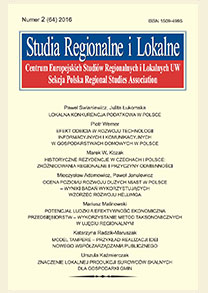Liberalizm i etatyzm w praktyce gospodarczej krajów Unii Europejskiej
Liberalism and statism in the economic practice of European Union countries
Author(s): Janusz HellerSubject(s): Economy
Published by: EUROREG - Uniwersytet Warszawski, Regional Studies Association - Sekcja Polska
Keywords: economic freedom; European Union; liberalisation; statism; economic crisis
Summary/Abstract: The aim of the research was to identify and measure the level of economic freedom across the EU at the turn of the 20th and 21st centuries. Special attention was paid to the changes in (i.e. liberalization of) the Polish economy. The basis of the comparative analysis between the 25 EU countries (excluding Malta and Cyprus) was provided by data acquired from the annual economic freedom study conducted by the Heritage Foundation and the Wall Street Journal in the years 1996–2008. The overall economic freedom index consisted of the average from marks for 10 different features – more detailed criteria. The average index acquired from all 10 features was the basis of a country’s mark for the level of liberalism (economic freedom) or statism. The proposed methodological approach, in which the two main currents of statism and liberalism are exposed, was especially useful in evaluating the processes occurring in the Polish economy. The results of the research show that, in the group of 15 countries of the “old” EU, 10 can be considered more liberal. This group includes, as the most liberal EU state of all, Ireland. The second group is formed of 5 countries apparently less liberal, i.e. Spain, France, Portugal, Italy and Greece. Poland is found to be the most statist country anywhere in the EU, notwithstanding its status (along with the Czech Republic and Estonia) as one of the three leaders of liberalism in the first years of transformation. In this situation it is hard to identify the Polish economy with advanced or even excessive liberalism. It is – according to the present standards – a rather state-controlled economy, albeit with certain but scarce elements of liberalism. The research shows that the economic crisis which occurred from mid 2007 cannot be identified only with the liberal economy, even though the implemented methods of dealing with the crisis seem to point to such a source. Statist solutions prevail here, but some liberal methods appear as well. A solution to this dilemma can only be anticipated after several years have passed.
Journal: Studia Regionalne i Lokalne
- Issue Year: 10/2009
- Issue No: 37
- Page Range: 27-45
- Page Count: 19
- Language: Polish

